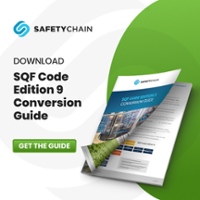A Checklist for Becoming SQF Certified
Becoming SQF certified offers several advantages for food and beverage companies. Like other Global Food Safety Initiative (GFSI) schemes, SQF certification helps facilities improve performance, promote safer products and operations, and optimize their resources. While there are several steps involved with becoming SQF certified, these advantages far outweigh the time and effort. Here’s what you should know about the certification.
What Is SQF?
SQF stands for Safe Quality Food. It is a program set forth by the SQF Institute with the goal of helping food and beverage manufacturers meet customer, industry, and regulatory requirements at every level of the supply chain. SQF is unique from other food safety certifications in the fact that it is the only program recognized by GFSI located outside of Europe. Nonetheless, it is recognized by retailers and food service providers worldwide.
What Is an SQF Certification?
An SQF certification is the accreditation issued to food and beverage companies after passing an audit from a licensed SQFI certification body. It demonstrates the facility’s commitment to the highest global food safety standards. Farms, warehouses, and food and beverage facilities are eligible for the program. With successful completion of initial and subsequent annual audits, these sites earn the designation of an SQF-Certified Site.
Why Is SQF Certification Important?
Incorporating an SQF program into your company offers several compelling benefits:
1. Manage Risks
SQF certification can promote more effective management of food safety hazards.
2. Maintain Current Customers
Many customers seek out the certification in their suppliers, as it offers a universal system for sound food safety practices. By pursuing and maintaining certification, you can keep your current customers satisfied in the knowledge that you’re continuously dedicating your efforts to safe, high-quality products.
3. Increase Market Reach
The certification helps you attract a broader customer base, as research suggests one in four companies request their suppliers to become certified.
4. Prepare for New Regulations
The SQF program bears some similarities to FSMA, the most sweeping reform of food safety laws to take place in more than seven decades. Thus, becoming certified may help companies prepare for the FDA’s enforcement of FSMA. Since SQF is updated regularly, it will also help companies continue to satisfy evolving regulatory requirements.
How to Get SQF Certified
The SQF Institute provides step-by-step instructions on how to become SQF certified.
Step 1: Educate Yourself
To learn about the SQF code, you can either train yourself, attend an instructor-led SQF course, take an online SQF class, or attend a day-long, in-person SQF seminar.
Step 2: Register
You’ll need to register your company in the SQF Assessment Database — fees are based on your gross revenues.
Step 3: Designate an Employee as an SQF Practitioner
Requirements for becoming an SQF Practitioner include attending a HACCP-based training program and understanding GMP (good manufacturing practices).
Step 4: Get Proposals from Certification Bodies (CBs) that Are SFQ-Licensed, and Consider an Optional Pre-Assessment
A pre-assessment can help you uncover and address safety or quality issues before your official audit.
Step 5: Schedule an Audit of Both Your Documents and Your Facilities
CBs are located around the globe so you can conveniently schedule your audit with one near your location.
What Are the SQF Levels?
There are three levels of certification for the SQF standard. Companies can choose which level to pursue, but the module consists of requirements assigned to facilities based on the nature of their business.
SQF Food Safety Fundamentals
Formerly known as SQF Level 1, this level is not GFSI-recognized but may be suitable for low-risk products. It focuses on foundational elements of food safety.
SQF Food Safety Code
Previously referred to as SQF Level 2 Certification, this level is a certified HACCP food safety plan benchmarked by GFSI. Most companies pursue this level. There are five core modules of the SQF Food Safety Code:
SQF Food Safety Code for Primary Production (This version is available for farmers of seafood, plant products, animal products, and grains.)
SQF Food Safety Code for Food Retail
SQF Food Safety Code for Manufacturer of Food Packaging
SQF Food Safety Code for Storage and Distribution
SQF Quality Code
Formerly known as Level 3, this code enforces robust safety and quality management measures. The primary focus is the Food Safety Code, with the SQF Quality Code added subsequently.
What Is SQF Edition 7.2?
Edition 7.2 of SQF code was released in July 2014. It introduced new protocols for unannounced recertification audits, Good Manufacturing Practices (GMPs) for food brokers and agents, and requirements for seasonal suppliers, among other developments.
What Is SQF Edition 8?
SQF edition 8 was introduced in 2017 to replace edition 7. It was updated to include a food safety code for retailers.
How Long Does It Take to Get SQF Certified?
While the audit itself will only take a few days at most, prepping for SQF certification can take several months. In general, companies can expect to spend 8-12 months preparing for certification.
Initial SQF certification requires a desk audit and a facility audit. The desk audit will take one half to a full day and is completed offsite. During this remote audit, the auditor reviews documentation, including your facility’s food safety plan. Should any nonconformances be discovered, they must be addressed prior to the onsite audit.
How Much Does SQF Certification Cost?
Typically, the two-day facility audit will cost between $7,300 and $9,000, before travel fees. Recertification can cost less ($4,500 to $6,000), also excluding travel expenses.
How Can SQF Software Help?
While adopting an SQF program certainly has its benefits, satisfying program requirements can also place new demands on your food safety and quality assurance (FSQA) teams. For companies using manual record keeping processes, adhering to SQF program standards can become an administrative burden. SQF solutions can alleviate the workload by ensuring program requirements are being met on an ongoing basis.
These solutions also provide real-time visibility into company operations, so managers have a better idea of where inefficiencies lie, which issues demand their attention, and how ongoing problems can be addressed. Moreover, SQF tools can capture data from a number of different sources and can send notifications any time out-of-spec results are captured. This allows food safety teams to react promptly, thereby minimizing any potential impact caused by a non-conformance. As a result, remaining compliant with all applicable food safety programs and regulations – SQF included – becomes simpler and more effective.
Clearly, becoming SQF certified is an undertaking that will demand considerable resources. For competitive, forward-thinking facilities, however, the payoffs are attractive. Moreover, if your facility already has powerful food safety measures in place, these will serve as a strong framework for SQF compliance.
About SafetyChain Software
SafetyChain is the #1 Plant Management Platform purpose-built to improve yield, maximize productivity, and ensure compliance standards for food, beverage, and consumer products. Learn more at https://safetychain.com.



